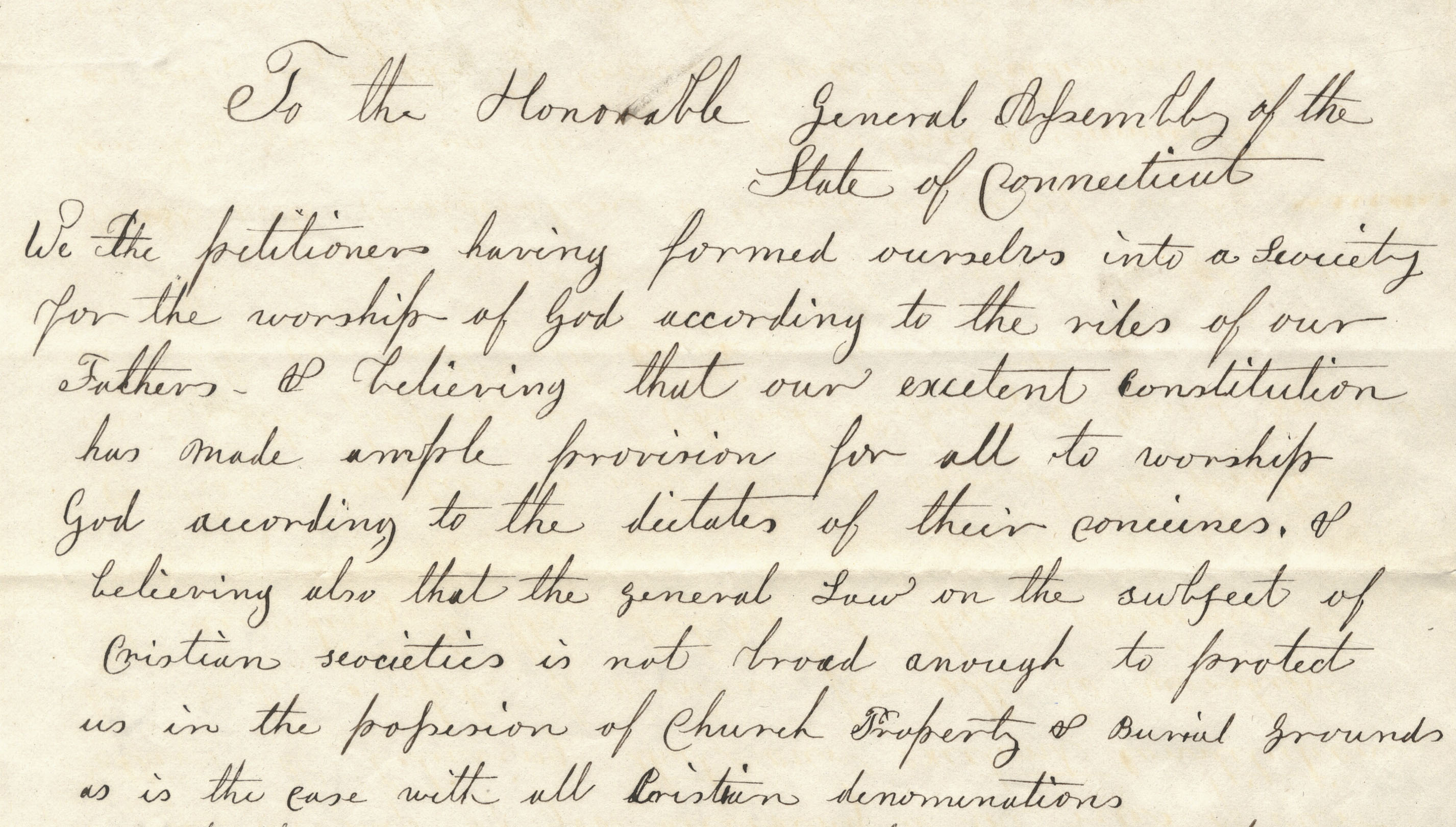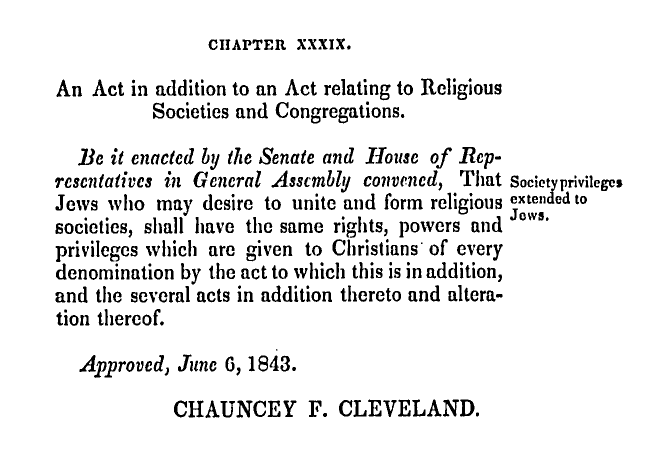Elizabeth Rose
Jewish Historical Society of Greater Hartford
TEACHER'S SNAPSHOT
Topics:
Belief & Religion, Civic Engagement, Early Republic, Law, Rights & Responsibilities of Citizens
Themes:
Cultural Diversity and an American National Identity, The Struggle for Freedom, Equality, and Social Justice
Grade:
Grade 8, High School
Historical Background
A small number of Jewish people lived in Connecticut as early as the 1650s, but they did not have the same rights as Christians. Connecticut had been established as a religious colony by Puritans and its laws linked government and the church. This meant that people of other religions did not have the ability to form their own congregations or worship in public. In 1818, the state adopted a new constitution which disconnected the Congregational church from the state government and gave all Christians the same religious rights. Some of the delegates wanted to remove the word “Christian” from the constitution to give these rights to members of all religions, but that effort failed. By the 1840s, more Jewish immigrants were settling in Connecticut cities and they wanted to establish synagogues and cemeteries to serve the needs of their communities. In 1843, a group of Jews from New Haven and Hartford petitioned the legislature to change the state constitution. The legislature did not agree to change the constitution, but they did pass a special law giving permission to Jews to form their own religious societies. This did not, however, give rights to any other non-Christians.
D1: Potential Compelling Question
D1: POTENTIAL SUPPORTING QUESTIONS
- Which groups were granted religious freedom in Connecticut’s 1818 Constitution, and which were left out?
- Did Connecticut’s restrictions on religious freedom conflict with the 1st Amendment to the United States Constitution?
- How did Jews use the right of petition (guaranteed in the 1st Amendment) to make change?
- What language did they use to persuade legislators to support their cause?
D2: TOOL KIT

Excerpts from pre-1843 documents: The Fundamental Orders (1639), Code of 1650, Connecticut Charter (1662), First Amendment to the United States Constitution (1789), and Connecticut Constitution (1818)

Petition by Ira Merwin, Agt (Agent) for Lewis Rothchild & others, 1843.
General Assembly papers, Connecticut State Library

Response to the 1843 Petition.
General Assembly papers, Connecticut State Library

Proposed Public Act in response to 1843 Petition.
General Assembly papers, Connecticut State Library

“An Act in Addition to an Act relating to Religious Societies and Congregations.” Approved June 6, 1843. Published in Public Acts, Passed by the General Assembly of the State of Connecticut, May Session, 1843, p 41.
D3: INQUIRY ACTIVITY
1) Introduce the compelling question and the concept of religious freedom in the context of early New England/Connecticut history. Ask students to help generate a list of supporting questions they have related to the inquiry. You may wish to introduce some of the questions listed above.
2) Have students read and annotate the excerpts from the pre-1843 documents individually, in pairs, or as a group. Students should consider: What did these early lawmakers have to say about the role of religion in society? What words/ideas do you see repeated most often? Are any of these texts contradictory, and if so, in what ways? What religious rights, if any, are guaranteed by these documents?
3) Next have students read the 1843 petition to the Connecticut General Assembly (both a scan of the original document and a transcription are provided.) What change are the Jewish petitioners seeking? What words/language do they use to make their argument?
4) Finally, students will read the response to the petition from the standing committee, along with the proposed public act and the new law as approved and published following the May 1843 session of the General Assembly. What changed as a result of the Jewish community’s petition?
5) Revisit the supporting and compelling questions. Are there questions that students feel have not been answered? Or new questions that have emerged? Where could they find out more?
D4: COMMUNICATING CONCLUSIONS
- Identify an issue of religious freedom in the United States today (e.g. observance of holidays, religious symbols, prayer in schools or public places). Summarize the arguments about this issue and explain how it relates to the concept of religious freedom as seen in these sources.
- Identify a change you would like to make in your community or your state and write your own petition. To whom will you address it, and how will you appeal for change? What can you do to make your petition more effective?
- Take on one of the following roles: delegate to the state constitutional convention in 1818, Jewish petitioner in 1843, or member of the legislature responding to the petition. Using the sources provided or additional ones you find and research, write a paragraph or more summarizing your position regarding the religious rights of Jews in Connecticut at the time and your reasoning behind your position.
- Find out how many synagogues exist in Connecticut today and what the size of the state’s Jewish population is.
a) Write about what you think would have happened if this change had not been made in 1843 to provide religious freedom for Jews in the state.
b) Find out how many churches, mosques, ashrams, or other places of worship there are in Connecticut and show this information in the form of a graph or map.
ADDITIONAL RESOURCES
Place to GO
Charter Oak Cultural Center, Hartford. Site of Connecticut’s first purpose-built synagogue.
Mishkan Israel, Hamden. The congregation that was the first to organize a synagogue in 1840.
Connecticut’s Old State House, Hartford. Site of Connecticut’s state government from 1796 to 1878.
Things To DO
Research the history of a local place of worship. When was the congregation established, what religion does it represent, and what is special about its building?
Websites to VISIT
First Amendment, Interactive Constitution, National Constitution Center.
Exploring Jewish Hartford: A Digital Tour, Jewish Historical Society of Greater Hartford.
Articles to READ
“The Importance of Being Puritan: Church and State in Colonial Connecticut” by Nancy Finlay. ConnecticutHistory.org.
“Gaining Religious Equality” by Mary Donohue. Connecticut Explored, Spring 2016.
“A Step toward Equality: The 200th Anniversary of Connecticut’s 1818 Constitution” by Denise Merrill.



